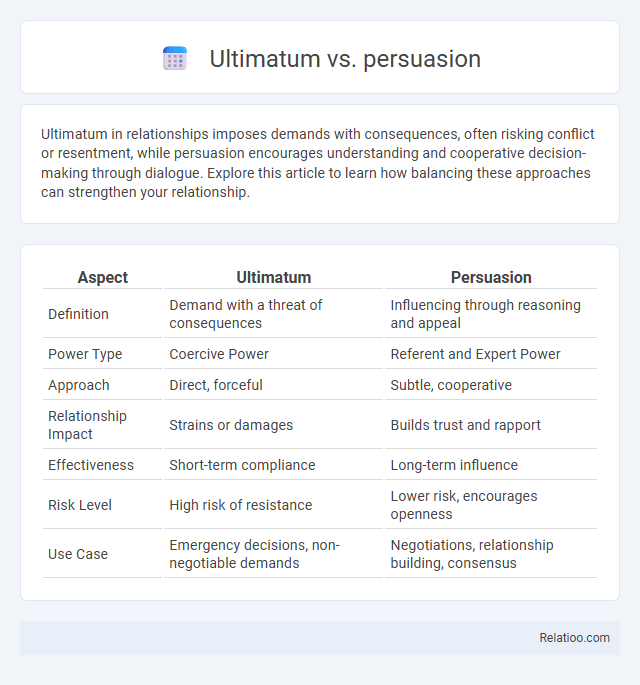Ultimatum in relationships imposes demands with consequences, often risking conflict or resentment, while persuasion encourages understanding and cooperative decision-making through dialogue. Explore this article to learn how balancing these approaches can strengthen your relationship.
Table of Comparison
| Aspect | Ultimatum | Persuasion |
|---|---|---|
| Definition | Demand with a threat of consequences | Influencing through reasoning and appeal |
| Power Type | Coercive Power | Referent and Expert Power |
| Approach | Direct, forceful | Subtle, cooperative |
| Relationship Impact | Strains or damages | Builds trust and rapport |
| Effectiveness | Short-term compliance | Long-term influence |
| Risk Level | High risk of resistance | Lower risk, encourages openness |
| Use Case | Emergency decisions, non-negotiable demands | Negotiations, relationship building, consensus |
Understanding Ultimatum and Persuasion
Understanding ultimatum and persuasion involves recognizing that an ultimatum presents a fixed demand backed by consequences, whereas persuasion aims to influence beliefs or actions through reasoning and appeal. Your ability to distinguish these approaches enhances communication strategies, ensuring you apply the right method for conflict resolution or negotiation. Effective persuasion often leads to collaborative outcomes, while ultimatums may risk resistance or compliance without genuine agreement.
Key Differences Between Ultimatum and Persuasion
Ultimatum involves issuing a final demand with a threat of consequences if not met, characterized by a rigid and coercive approach. Persuasion relies on reasoning, emotional appeal, and dialogue to influence attitudes or behaviors without threats. The key difference lies in ultimatum's emphasis on non-negotiable terms backed by potential penalties, whereas persuasion seeks voluntary agreement through mutual understanding.
Psychological Foundations of Ultimatum
The psychological foundations of ultimatum revolve around the desire for fairness, social norms, and emotional reactions to perceived threats or demands. Ultimatums trigger cognitive processes related to reciprocity and justice, often leading individuals to accept or reject offers based not only on monetary gain but also on the perceived fairness of the interaction. Unlike persuasion, which relies on influencing attitudes through reasoning and emotional appeal, ultimatums impose a fixed demand, leveraging power dynamics and fear of loss to elicit compliance or resistance.
The Art of Persuasion: Core Principles
The Art of Persuasion centers on understanding the audience's values and emotions to craft compelling messages that inspire action without coercion. Unlike ultimatum tactics that impose conditions or threats, persuasion builds rapport and trust to guide Your decisions. Mastering principles such as reciprocity, social proof, and clarity enhances your ability to influence effectively and ethically.
When to Use an Ultimatum
Use an ultimatum when a clear, non-negotiable boundary must be established to prompt immediate action or change, especially in situations where stakes are high and previous attempts at persuasion have failed. Ultimatums are effective in crisis management, conflict resolution, or decision-making scenarios requiring decisive outcomes within a limited timeframe. Unlike persuasion, which relies on influencing attitudes and behaviors through reason or emotion, ultimatums deliver a stark choice that emphasizes consequences to enforce compliance.
Advantages and Disadvantages of Ultimatums
Ultimatums offer clear boundaries and immediate decision-making, ensuring that the opposing party understands non-negotiable terms, which can expedite conflict resolution. However, ultimatums risk damaging relationships and reducing cooperation by creating pressure and resentment, potentially leading to resistance or breakdown in communication. Unlike persuasion, which seeks to influence gradually through reasoning and mutual benefits, ultimatums rely on authority and finality, limiting flexibility and adaptability in negotiations.
Pros and Cons of Persuasion Techniques
Persuasion techniques leverage logic, emotion, and credibility to influence decisions while fostering cooperation and long-term relationships, making them valuable in negotiation and marketing contexts. You benefit from increased trust and a higher chance of voluntary agreement, but these methods can be time-consuming and less effective if the audience is resistant or biased. Compared to ultimatums, which offer clear-cut demands but risk conflict and damaged relationships, persuasion promotes mutual understanding but may lack immediate enforceability.
Impact on Relationships: Ultimatum vs Persuasion
Ultimatums often create tension and resentment, risking long-term damage to your relationships by imposing strict demands that can feel controlling or threatening. Persuasion, however, fosters trust and open communication by encouraging mutual understanding and cooperation, strengthening bonds through respectful dialogue. Choosing persuasion over ultimatums enhances relationship durability and emotional connection, promoting collaborative problem-solving rather than conflict.
Real-World Examples: Ultimatums vs Persuasion
Ultimatums often involve clear, non-negotiable demands with consequences if not met, such as a government issuing an ultimatum during diplomatic conflicts that threatens sanctions or military action, while persuasion relies on influencing through reasoning and appeals, evident in marketing campaigns that shape consumer behavior without explicit threats. In labor disputes, a union may present ultimatums to management demanding immediate wage increases or face strikes, contrasting with persuasive negotiation strategies aiming for mutual agreement and compromise. The stark difference lies in ultimatums driving compliance through pressure, whereas persuasion fosters cooperation and voluntary agreement through motivation and dialogue.
Choosing the Right Approach for Effective Communication
Choosing the right approach between ultimatum and persuasion significantly impacts communication effectiveness, as ultimatums impose strict demands often leading to resistance, while persuasion encourages collaboration and mutual understanding. Utilizing persuasion techniques such as appealing to logic and emotions fosters trust and long-term relationships, whereas ultimatums may expedite decisions but risk damaging rapport. Analyzing the context, audience, and desired outcome ensures selecting the most appropriate strategy for clear, respectful, and impactful communication.

Infographic: Ultimatum vs Persuasion
 relatioo.com
relatioo.com